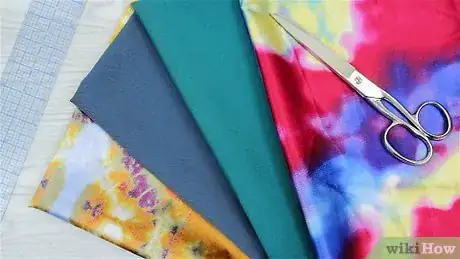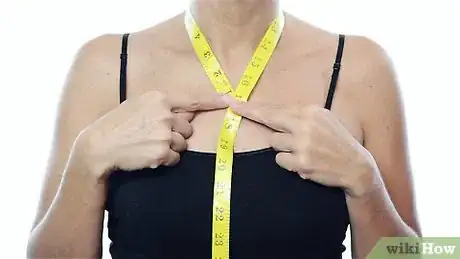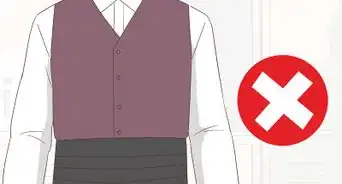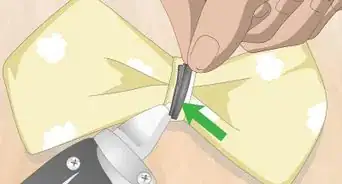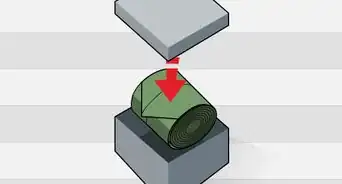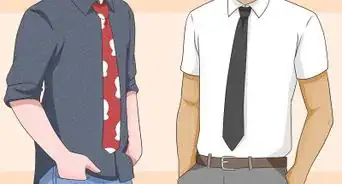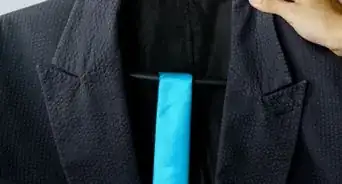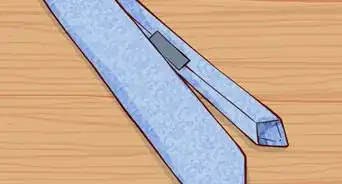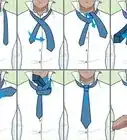This article was co-authored by Alessio Iadicicco. Alessio Iadicicco is an Apparel Manufacturing Specialist and the CEO and Co-Founder of MarkersValley, an online apparel and manufacturer sourcing platform that connects luxury fashion brands to a network of highly-vetted, truly Italian manufacturers. He holds a Bachelor's degree in Economy and Management of Financial Enterprises from The University of Naples Federico II. MarkersValley has connected fashion brands in over 100 countries and has a network of over 100 independent Italian factories and artisans. MarkersValley has been featured in Forbes, EQ, St. Louis Business Journal, Il Mattino, and Corriere Della Sera.
This article has been viewed 167,029 times.
A cravat is a decorative neck scarf that originated in seventeenth-century Croatia, and which eventually developed into modern neckwear. Today, the term cravat is a general term for neckwear that can be applied to bowties, neckties, and ascots, but it’s also used to refer to an older style of tie that’s typically worn over the shirt.[1] Cravats are still popular for some traditional uniforms, for formal occasion dress, among historical enthusiasts, and in the Victorian-inspired Steampunk culture. Making a cravat is a fun project that doesn’t require too many tools, and the finished scarf will allow you to experiment with different styles and knots.
Steps
Creating a Pattern
-
1Choose a fabric. You can use any pattern you like and any fabric, but cravats are typically made with soft fabrics (as opposed to stiff ones) that are more comfortable to wear and easier to wrap and tie.[2] You can even use two different fabrics if you’d like to make a reversible cravat. Popular fabric choices include:[3]
- Satin
- Soft cotton
- Muslin
- Silk
-
2Gather your supplies. For this project, you will need some pins, a sewing machine, thread, scissors, a steam iron and ironing board, a measuring tape, a flat work area (such as a table), pattern paper and a pencil, a pattern pencil or chalk, and two strips of fabric that are at least 9 inches (23 cm) wide and about 2.2 yards (2 meters) long.[4]
- To make a cravat that only wraps once around your neck, the fabric can be only 1.6 yards (1.5 meters).
- If you don’t have access to a sewing machine, you can hand stitch the cravat, meaning you’ll need a sewing needle instead.
Advertisement -
3Measure your neck. Whatever that measurement is, subtract one-half inch (1.3 cm), and divide that in half. Write this measurement down, as you will need it in the next step to create your pattern.
- To make a generic or one-size cravat, use eight or nine inches as your measurement.
-
4Draw the pattern. You'll need to create a pattern before you can start cutting and sewing your cravat.[5] Draw a rectangle that’s 2.5 inches (6.3 cm) wide and the correct length based on the neck measurement from the previous step.
- Now, connect that rectangle to an elongated hexagon that’s 7 inches (17.8 cm) wide,[6] and between 21 and 31 inches (53 to 78.8 cm) long, depending on how long you want your cravat to be.
- Make sure the center of the original rectangle connects with the lengthwise center of the hexagon.
- When you are finished, cut out the pattern.
Making the Cravat
-
1Lay out the pattern. Take both your strips of fabric and fold them in half widthwise. With the folds together, lay them out on a flat surface. Place the pattern on top of the fabric, and position the very top of the neckband along the straight folds of the fabric.
- Pin the pattern in place, making sure to go through all four layers of fabric.
-
2Trace and cut. Use your chalk or fabric pencil to draw the pattern out on the fabric. Carefully remove the pattern and replace the pins to hold the fabric in place. Cut out the two pieces of your cravat.
-
3Lay the fabric. Open the folds so that your two cravat pieces open up. Lay them out on a flat surface with the good sides of the fabric pieces facing inward (facing each other). Pin the edges together.
-
4Sew the cravat with a straight stitch. Be sure to leave the bottom triangle open so that you can turn the cravat right side out when you are finished. Make sure you back stitch at the beginning and end.
- Use a one-quarter to one-half inch (0.6 to 1.3 cm) seam allowance.
-
5Snip the corners. Anywhere there is a corner on the cravat, make a notch with a single snip in the fabric that bisects the angle of the corner. This will help create cleaner edges. Make sure you stop before cutting the seam.
-
6Turn the cravat right side out. When you have pulled the right sides of the fabric through, carefully press the edges around the entire cravat.
- Be sure to use the correct iron setting.
-
7Sew the bottom closed. Use your iron to press up the open fabric ends, following the same one-quarter to one-half inch (0.6 to 1.3 cm) seam allowance. Pin the edges together, and either top stitch the bottom or use a needle and thread to create a blind stitch.
Tying a Cravat
-
1Hang the cravat around your neck. You want both ends hanging down on your chest. Adjust the cravat so the right is slightly longer than the left. Bring the right side across the top of the left side.
-
2Loop the right side behind the left. The left and right sides should now be back on their original side, but the right side is now wrapped around the left.
-
3Cross the right over the front of the left again. Wrap the right side around the back, and then pull the right side up through the center of the neck band.
-
4Tie a casual cravat. Fold the fabric over the top of the neckband so it hangs down the front center of your chest. Tuck the extra fabric into the opening of your collared shirt.[7]
-
5Tie a wedding cravat. Follow the same procedure as for the casual cravat, but instead of tucking the excess fabric into your shirt, tuck it into your vest.
- If you like, use a cravat pin to keep the top layer of fabric in place.
-
6Make a scrunchie wedding cravat. Take the fabric that you pulled up and over the neck band, and tuck it into the fabric loops that you created by wrapping the cravat. Adjust the knot and tuck the excess fabric into your shirt or vest.[8]
Expert Q&A
-
QuestionWhat fabric should you use to make a cravat?
 Alessio IadiciccoAlessio Iadicicco is an Apparel Manufacturing Specialist and the CEO and Co-Founder of MarkersValley, an online apparel and manufacturer sourcing platform that connects luxury fashion brands to a network of highly-vetted, truly Italian manufacturers. He holds a Bachelor's degree in Economy and Management of Financial Enterprises from The University of Naples Federico II. MarkersValley has connected fashion brands in over 100 countries and has a network of over 100 independent Italian factories and artisans. MarkersValley has been featured in Forbes, EQ, St. Louis Business Journal, Il Mattino, and Corriere Della Sera.
Alessio IadiciccoAlessio Iadicicco is an Apparel Manufacturing Specialist and the CEO and Co-Founder of MarkersValley, an online apparel and manufacturer sourcing platform that connects luxury fashion brands to a network of highly-vetted, truly Italian manufacturers. He holds a Bachelor's degree in Economy and Management of Financial Enterprises from The University of Naples Federico II. MarkersValley has connected fashion brands in over 100 countries and has a network of over 100 independent Italian factories and artisans. MarkersValley has been featured in Forbes, EQ, St. Louis Business Journal, Il Mattino, and Corriere Della Sera.
Apparel Manufacturing Specialist Try using silk, satin, or another type of soft material to make your cravat.
Try using silk, satin, or another type of soft material to make your cravat.
References
- ↑ https://www.youtube.com/watch?v=IUBjyaTiUQw
- ↑ Alessio Iadicicco. Apparel Manufacturing Specialist. Expert Interview. 16 June 2021.
- ↑ https://www.youtube.com/watch?v=IUBjyaTiUQw
- ↑ https://teainateacup.wordpress.com/2012/05/22/my-mr-knightley-making-a-neckcloth/
- ↑ Alessio Iadicicco. Apparel Manufacturing Specialist. Expert Interview. 16 June 2021.
- ↑ http://www.cutoutandkeep.net/projects/pre-tied-victorian-cravat
- ↑ https://www.swaggerandswoon.com/guides/how-to-tie-a-wedding-casual-cravat.php
- ↑ http://www.tomsawyerwaistcoats.co.uk/store/showitemHOW-SCRUNCHIE.aspx
